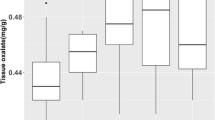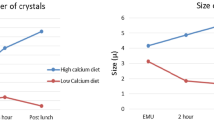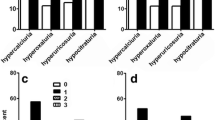Abstract
Various studies have suggested that potassium depletion leads to acidosis and hypocitraturia. In Northeastern Thailand, for example, mild hypokalemia and mild hyperoxaluria are observed in most stone formers. However, there are limited reports about the direct link between potassium depletion and the formation of urinary stones, most of which are calcium oxalate stones. Therefore, we studied the direct effect of potassium depletion on the risk factors for calcium oxalate stone formation. Seventy-two rats were fed a control diet or a potassium-deficient diet for 1, 2, or 3 weeks (n = 12 per group). Twenty-four-hour urine collection was done for the measurement of potassium, calcium, oxalate, glycolate, citrate, phosphorus, and magnesium. Lactate dehydrogenase activity was also measured in order to assess renal tubular damage, and kidneys were harvested for histological examination. Furthermore, urinary supersaturation of calcium oxalate was calculated. With potassium depletion, the urinary concentrations of potassium, citrate, magnesium, and phosphorus decreased rapidly. There was no detectable renal damage, renal calcium deposition, and no significant increase of urinary oxalate or calcium. However, the urinary supersaturation index of calcium oxalate increased significantly in rats with potassium depletion. These findings indicate that potassium deficiency may increase the risk of stone formation through enhanced supersaturation.


Similar content being viewed by others
References
Sutherland JW, Parks JH, Coe FL et al (1985) Recurrence after a single renal stone in a community practice. Miner Electrolyte Metab 11(4):267–269
Yanagawa M, Kawamura J, Onishi T et al (1997) Incidence of urolithiasis in northeast Thailand. Int J Urol 4(6):537–540
Coe FL, Evan A, Worcester E et al (2005) Kidney stone disease. J Clin Invest 115(10):2598–2608
Hossain RZ, Ogawa Y, Hokama S et al (2003) Urolithiasis in Okinawa, Japan: a relatively high prevalence of uric acid stones. Int J Urol 10(8):411–415
Bovornpadungkitti S, Sriboonlue P, Tavichakorntrakul R et al (2000) Potassium, sodium and magnesium contents in skeletal muscle of renal stone-formers: a study in an area of low potassium intake. J Med Assoc Thai 83(7):756–763
Lelamali K, Khunkitti W, Yenrudi S et al (2003) Potassium depletion in a healthy north-eastern Thai population: no association with tubulo-interstitial injury. Nephrology 8:28–32
Ray EP, Suga SI, Liu XH et al (2001) Chronic potassium depletion induces renal injury, salt sensitivity, and hypertension in young rats. Kidney Int 59:1850–1858
Tosukhowong P, Boonla C, Ratchanon S et al (2007) Crystalline composition and etiologic factors of kidney stone in Thailand. Asian Biomed 1(1):89–97
Robertson WG (1986) Pathophysiology of stone formation. Urol Int 41(5):329–333
López M, Hoppe B (2008) History, epidemiology, and regional diversities of urolithiasis. Pediatr Nephrol. doi:10.10071/s00467-008-0960-5
Morozumi M, Hossain RZ, Yamakawa K et al (2006) Gastrointestinal oxalic acid absorption in calcium-treated rats. Urol Res 34(3):168–172
Milosević D, Batinić D, Blau N et al (1998) Determination of urine saturation with computer program EQUIL 2 as a method for estimation of the risk of urolithiasis. J Chem Inf Comput Sci 38(4):646–650
Youngjermchan P, Pumpaisanchai S, Ratchanon S et al (2006) Hypocitraturia and hypokaliuria: major metabolic risk factors for kidney stone disease. Chula Med J 50(9):605–621
Tosukhowong P, Sriboonlue P, Tungsanga K et al (2001) Potassium status of Northeast Thai constructors in three different geographic locations. J Med Assoc Thai 84(Suppl 1):S163–S172
Levi M, McDonald LA, Preisig PA et al (1991) Chronic K depletion stimulates rat renal brush-border membrane Na-citrate cotransproter. Am J Physiol Renal Physiol 261:767–773
Napradit P, Pholpramool C, Jariyawat S et al (1995) Extrarenal potassium homeostasis after chronic potassium deficiency in rats. In: Japanese and Thai collaborative study group (ed) Lai Tai, sudden unexplained death syndrome, Tokyo, pp 71–104
Halperin ML, Dhadli SC, Kamel KS (2006) Physiology of acid–base balance: links with kidney stone prevention. Semin Nephrol 26:441–446
Pak CYC (1994) Citrate and renal calculi; new insights and future directions. Am J Kidney Dis 17:420–425
Hamm LL (1990) Renal handling of citrate. Kidney Int 38(4):728–735
Domrongkitchaiporn S, Stitchantrakul W, Kochakarn W (2006) Causes of hypocitraturia in recurrent calcium stone formers: focusing on urinary potassium excretion. Am J Kidney Dis 48:546–554
Stitchantrakul W, Kochakarn W, Ruangraksa C et al (2007) Urinary risk factors for recurrent calcium stone formation in Thai stone formers. J Med Assoc Thai 90(4):688–698
Thongboonkerd V, Kanlaya R, Sinchaikul S et al (2006) Proteomic identification of altered proteins in skeletal muscle during chronic potassium depletion: implications for hypokalemic myopathy. J Proteome Res 5:3326–3335
Tavichakorntrakool R, Sriboonlue P, Prasongwattana V et al (2009) Metabolic enzymes, antioxidants, and cytoskeletal proteins are significantly altered in vastus lateralis muscle of K-depleted cadaveric subjects. J Proteome Res 8:2586–2593
Kahn SR (1998) Importance of calcium phosphates in the development of calcium urolithiasis. In: Zahid Amjad (ed) Calcium phosphates in biological and industrial systems, USA, pp 253–275
Breusegerm S, Takahashi H, Giral-Arnal H et al (2009) Differential regulation of the renal sodium/phosphate co-transporters NaPi-IIa, NaPi-IIC and PiT-2 in dietary potassium deficiency. Am J Physiol Renal Physiol. doi:10.1152/ajprenal.90765.2008
Suga SI, Phillips MI, Ray PE et al (2001) Hypokalemia induces renal injury and alterations in vasoactive mediators that favor salt sensitivity. Am J Physiol Renal Physiol 281:F620–F629
Tolins JP, Hostetter MK, Hostetter TH (1987) Hypokalemic nephropathy in the rat: role of ammonia in chronic tubular injury. J Clin Invest 79:1447–1458
Author information
Authors and Affiliations
Corresponding author
Rights and permissions
About this article
Cite this article
Yachantha, C., Hossain, R.Z., Yamakawa, K. et al. Effect of potassium depletion on urinary stone risk factors in Wistar rats. Urol Res 37, 311–316 (2009). https://doi.org/10.1007/s00240-009-0220-6
Received:
Accepted:
Published:
Issue Date:
DOI: https://doi.org/10.1007/s00240-009-0220-6




